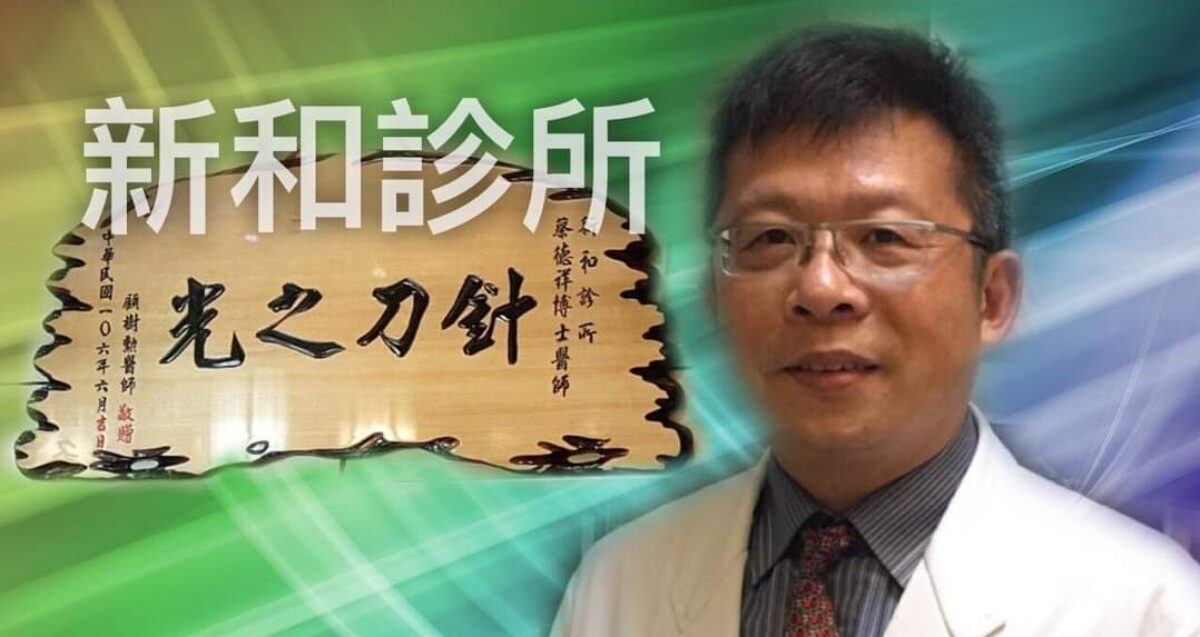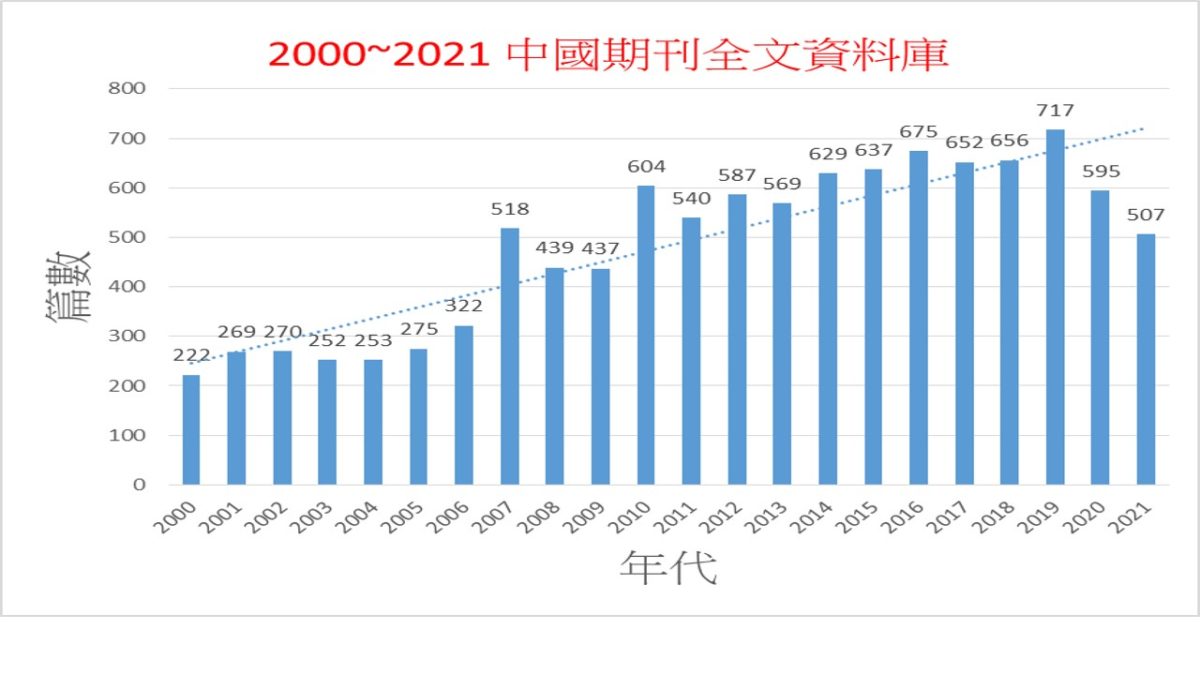小針刀疼痛治療簡介與實證醫學
台北市中醫師公會 首都中醫報導
作者: 蔡德祥 中西醫師 博士
學經歷: 台北市中醫師公會理事 台灣針刀專科醫學會理事 部定助理教授 新和診所負責人
前言
根據2015年英國大規模研究統合分析顯示,慢性疼痛盛行率佔35%-51%,其中中重度約佔10%-14%,隨者年紀增長,到75歲齊盛行率達到62%, 其中女性比男性多,約六成與四成比。疼痛治療在西醫治療方面日新月異,在中醫也不斷推陳出新,中醫近年對於疼痛治療發展尤其是小針刀療法,在中國大陸已發展40年,已獲得突破性的進步,除了治療疼痛方面,對於其他內科、外科、醫美治療也有非凡成就。本文主要探討肌肉骨骼疼痛,其他雜病不在探討範圍。(1-4)
小針刀療法簡介(1-5)
小針刀療法是將傳統的針刺療法與現代手術療法結合的一種閉合性手術療法,小針刀外形似針灸的針,尖端扁平,在台灣使用的針刀,一般長度約3-5 cm,最小寬度可至0.35 cm,可發揮針刺及刀刃的雙重功能,在筋骨科領域應用廣泛。其特色是簡、便、廉、驗。所以針刀醫學是中西結合的醫學。針刀治療十六字箴言,針刀為主,手法為輔,藥物配合,器械輔助。(1-4)
針刀流派簡介(1-5)
60年代山東黃榮發: 創制“小寬針”,形成“小寬針”療法。
70年代天津任志遠: 創制“針灸刀”,形成“針灸刀”療法。
1976年江蘇朱漢章: 發明“小針刀”,創立小針刀療法,發展成“針刀醫學”,這一派是目前主流,發展最完全,組織最龐大,也是今天討論的主題。
80年代北京奚達在小針刀基礎上創制“針刀”,形成針刀藥結合療法。
1992年吉林肖萬坤: 創立“軟組織損傷松針療法”。
1993年西安黃樞: 發明了“帶刃針”,創立《中國針法微型外科學》 。
小針刀療法起源、發展和推廣(1-5)
起源
1976 年春,朱漢章教授利用 9 號注射針頭,成功解決掌腱膜的鬆解。
1984 年,成立第一家以針刀療法為特色的金陵骨傷科醫院。
發展
1992 年,出版 “小針刀療法”
2001 年,出版 ”針刀醫學原理”
2003 年,國家中醫藥管理局,正式命名為”名針刀醫學”
2006 年,高校開始招收針刀碩士和博士生
推廣
1987 年以來,美、日、澳大利亞等40 多國家培訓傳播
1990 年,中國小針刀療法研究會成立
1990 年,中華中醫藥學會針刀醫學分會成立
2009 年,中國針灸學會微創針刀專業委員會成立
2013 年,中國中醫藥促進化針刀專業委員會成立
2015 年,中國民族醫學會針刀專業委員會成立
~2018年, 中國境內 28個省和直轄市,相繼成立針刀醫學會
朱漢章教授簡歷
1949年8月出生於中國江蘇省淮陰市。(現在的宿遷市泗陽縣)
1955年入學讀書至1968年高中畢業。朱漢章
1969年在沭陽縣沭南醫務所從事初級醫務工作,從師學醫。
1976獲大學學歷(72年考入南京中醫學院)。
1978年升沭陽縣中醫院副院長(76年分配到沭陽縣中醫院工作,定為醫師職稱)。
1979年調江蘇省中醫院骨傷科工作,晉升主治醫師、小針刀療朱漢章
法科研課題負責人。
1984年小針刀療法通過國家鑒定,同年任南京金陵中醫骨傷醫院院長。
1985年晉升骨傷科副主任醫師,兼南京中醫藥大學副教授。
1989年調往南京中醫藥大學附屬醫院任業務院長。
1990年晉升為主任醫師、教授,同年出版《腰痛》一書。
1991年翻譯出版《膝關節外科學》。
1992年《小針刀療法》出版,同年又出版了《中國推拿手法180種》。
1993年調往北京中國中醫研究院,任該院附屬醫院—–長城醫院院長,小針刀療法通過中央鑒定,並由專家委員會定名為針刀醫學,現全世界有接受針刀醫學培訓的醫生二萬餘人,活躍在40多個國家和地區醫療崗位上。
1995年兼任中國中醫研究院針刀醫學培訓學校校長。
2000年被美國科學院評定為該院院士。(存疑)
2001年四月調入北京中醫藥大學,任北京中醫藥大學針刀醫學研究教育中心主任,責任編寫大學教材和科研工作。
於2006年10月14日早6時30分,因公在外講學期間突發急性心肌梗塞,經全力搶救無效,不幸逝世,終年57歲。
小針刀器具簡介(1-5)
小針刀是將針灸和手術刀融為一體的小型治療器具。它是由Cr 做成,彈性好、韌性大、不易折斷、不易彎針。小針刀組成部分包括,針體、針柄及針刃三部分。
中國大陸最小針刀針刃寬度為0.8 cm。台灣最小針刀針刃寬度可小至0.35 cm
中國大陸小針刀器械
I 型齊平口針刀
II 型截骨針刀(小號)
III 型截骨針刀(大號)
IV 型斜口針刀
V 型圓刃針刀
VI 型凹刃針刀
VII 型劍鋒針刀
VIII 型注射針刀
IX 型鳥嘴刃針刀
X 型剪刀刃針刀
XI 型芒針刀
XII 型旋轉刃針刀
XIII 型探針式針刀
XIV 型彎形針刀
中國大陸其他針刀器械名稱
水針刀、銀針刀、弧針刀、超微針刀、筋骨針刀等等。
台灣針刀器械
刃針
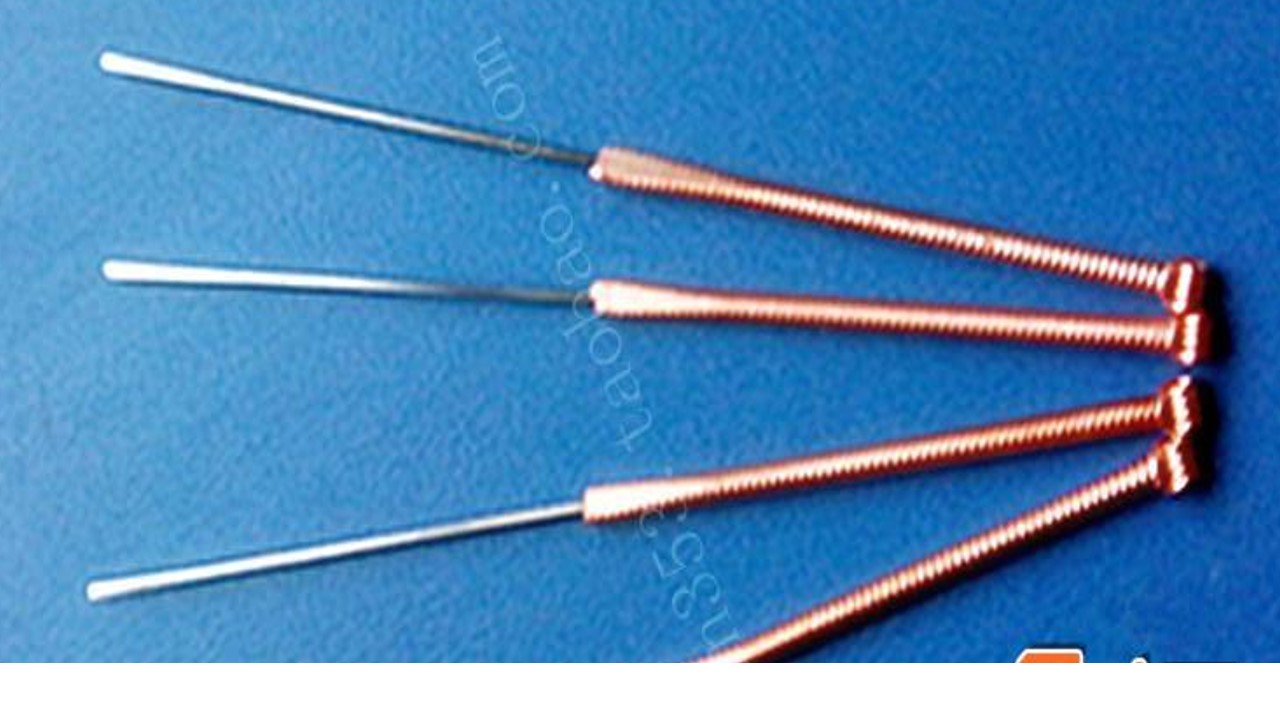
小針刀
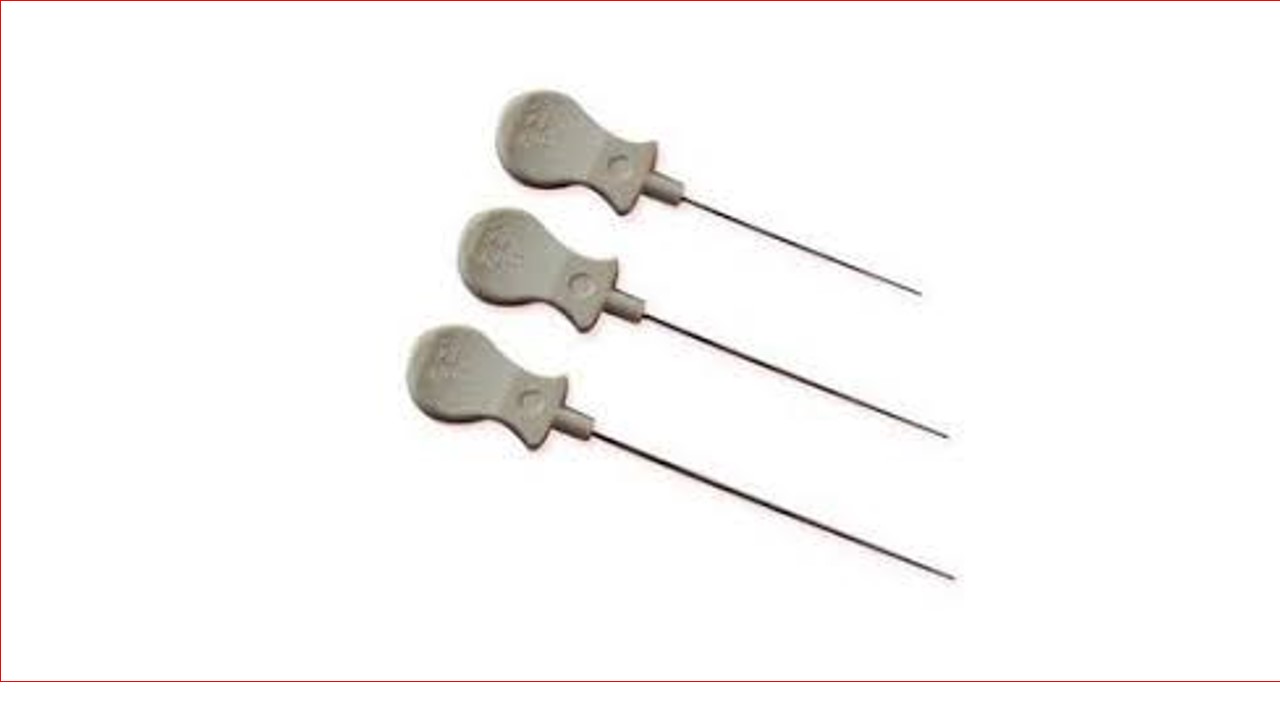
小針刀四大特色(1-5)
簡(治療簡單): 無切口、少流血、痛苦小。
便(應用方便): 器械小、易攜帶、配套少。
廉(費用低廉): 成本低、投資低、費用低、
驗(效果明確): 立見效,三次佳,六次癒。。
小針刀七大轉變(1-5)
填補性: 將大量疾病從不治變為可治。
技術性: 將難治變為速癒。
創新性: 將開放性手術變為閉合性手術。
簡易性: 將複雜治療變為簡單治療。
微創性: 將損傷型或痛苦型治療變為近於無損傷、小痛苦治療。
實用性: 將黃帝內經筋膜理論,變為實際治療。
示範性: 將中醫器械由傳統毫針展為現代化針刀針具。
小針刀作用 (1-5)
針的作用: 針刺作用
刀的作用: 切開作用、牽拉作用
小針刀效應(1-5)
分離粘連、延長攣縮、減張減壓、局部破壞、針刺鎮痛。
小針刀治療部位(1-5)
筋膜或肌肉粘連、攣縮、結疤或阻塞軟組織部位處。
小針刀適應症(1-5)
軟組損傷
筋膜炎、腱鞘炎、韌帶炎、神經卡壓症。
關節脊椎相關疾病
脊椎的某些病變、四肢關節的退行性或損傷性病變、缺血性骨壞死、骨幹骨折的畸形癒合。
手術後沾黏
小針刀治療間隔和療程(1-5)
基礎療程: 視疾病嚴重度和急慢性,一般3-7天可治療一次 (可和針灸交替使用),一個基礎療程約6次。
維持療程: 視疾病嚴重度,決定是否要每兩週到一個月治療一次,維持療程時間也是視疾病嚴重度。
小針刀禁忌症(1-5)
絕對禁忌症
診斷不明確、解剖不確定、針刀處感染 (若目的為切開化膿非禁忌症)
相對禁忌症
全身感染、出血傾向、內科疾病不穩定、針刀處週邊感染、難以避開的重要血管、神經或內臟。
小針刀操作方法(1-5)
持針法: 單手持針、雙手持針 。
進針法: 定點、定向、加壓分離、刺入
入路技巧: 一般入路技巧 、骨性標誌入路技巧 、肌腱性標誌入路技巧 、肌腱附著點入路技巧、組織層次入路技巧 。
調針法: 調轉刀口線、移動刀鋒位置
運針法: 切、堆、擺、鏟、磨
控針法: 把握針刀支點、咬住骨面、控制力度。
出針法: 加壓、止血
醫師手感: 肌肉呈現 柔軟感、筋結呈現硬結感、血管呈現阻力大後消失感、組織間隙呈現空虛感、骨頭呈現堅硬感 。
病患針感: 筋結呈現 酸、脹感、血管呈現痛感、神經呈現 觸電感。
小針刀注意事項(1-5)
暈針、折針、出血、神經損傷 、氣胸 、感染 、內臟損傷
精準小針刀
目前西醫治療疾病趨勢,強調精準,小針刀療法也是強調精準,診斷精準,治療精準,徒手治療精準,復健精準。
可視化小針刀
利用超音波導引,可協助精準定位肌痛點(阿是穴)所在。
台灣職業現況及台灣針刀學會
凡中醫師或西醫師上過中國醫藥大學龜廣教育中心舉辦的針灸研習班,皆可執行小針刀。小針刀價位,因為非健保給付項目,由各縣市衛生局核定,台北核定針刀治療為1400元。台灣各地常出現的各種治療名稱,如圓針療法,鈹針療法,扁針療法,其實都是小針刀療法。針刀器械廠商,目前所知道的有兩家代理,即東方鍼和佳順兩家代理。台灣所使用的小針刀,稱為刃針(類似針灸針,沒有葫蘆柄,針肩扁平; 小針刀器械定義需有葫蘆柄)。台灣針刀醫學會成立於2014年8月31日,目前有會員百餘人,定期教學和研習,每年舉辦針刀專科醫師考試 (非部定),供同好切磋技藝,與時同進。
小針刀實證醫學(中國大陸)
自2000年起至2018 年11月止,自中國期刊全紋資料庫查詢,以關鍵字”針刀”,共查出11,217 篇有關針刀的文獻(圖一)。其中以2013 年接近900篇最多。自1978年針刀與筋膜炎相關文獻有3205篇,與肩周炎相關文獻有1149篇,與椎間盤突出相關文獻有1204篇,與膝關節炎相關文獻有1704篇(圖二)。雖然有如此多的文獻報告,但其證據等級仍偏低,有待補強。然自PubMed libraray 查詢有關針刀的文獻,確很少。(圖三)
圖一 2000~2021 中國期刊全文資料庫文獻
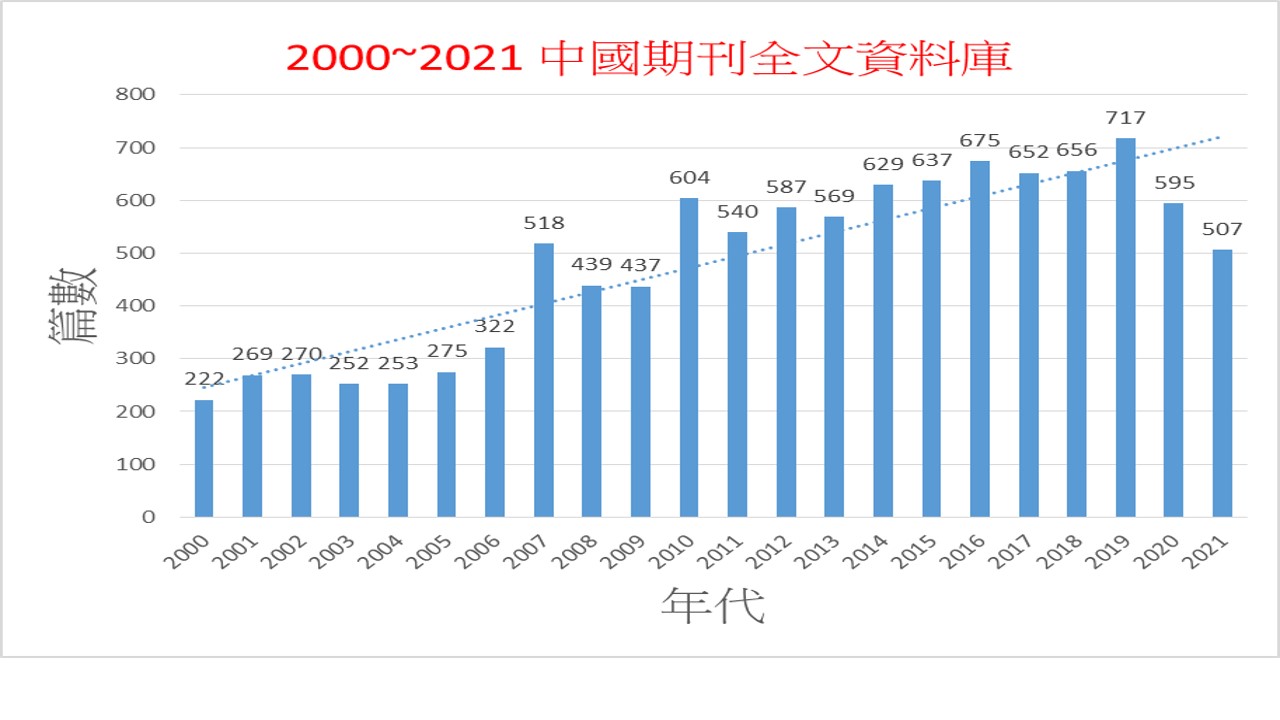
圖二 2000~2021 中國期刊全文資料庫
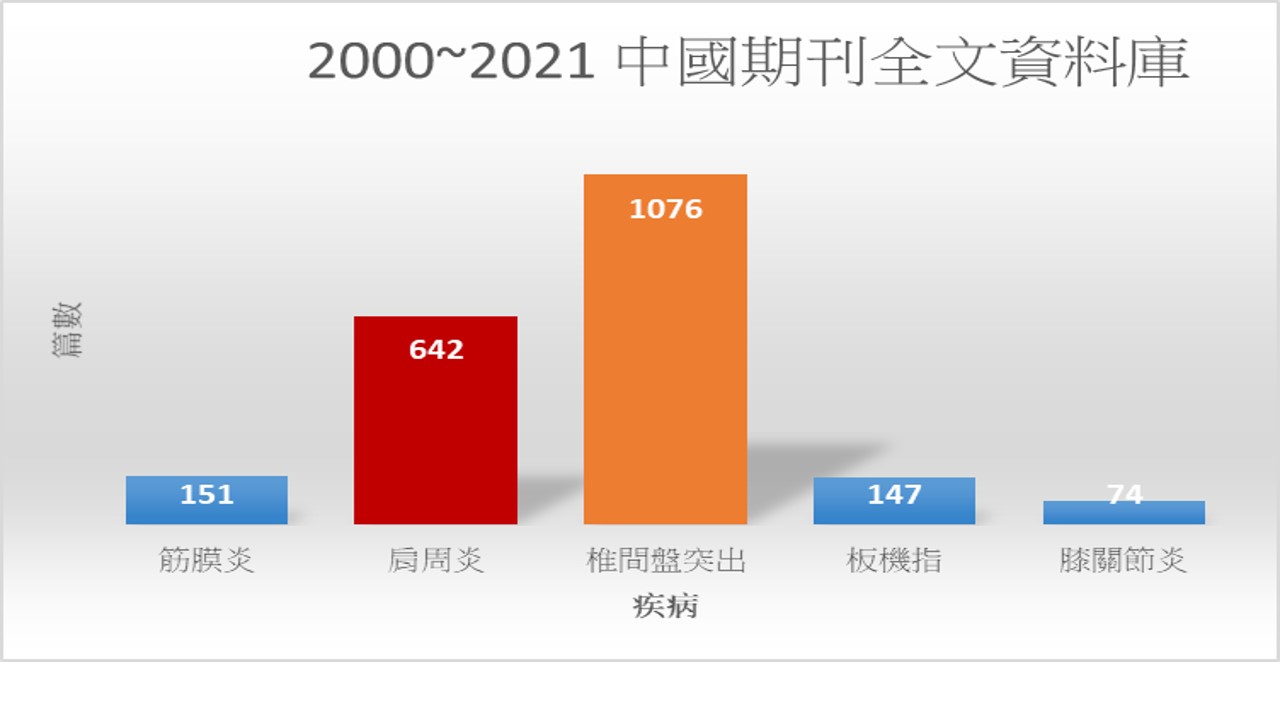
圖三 2000~2021 中國期刊全文資料庫
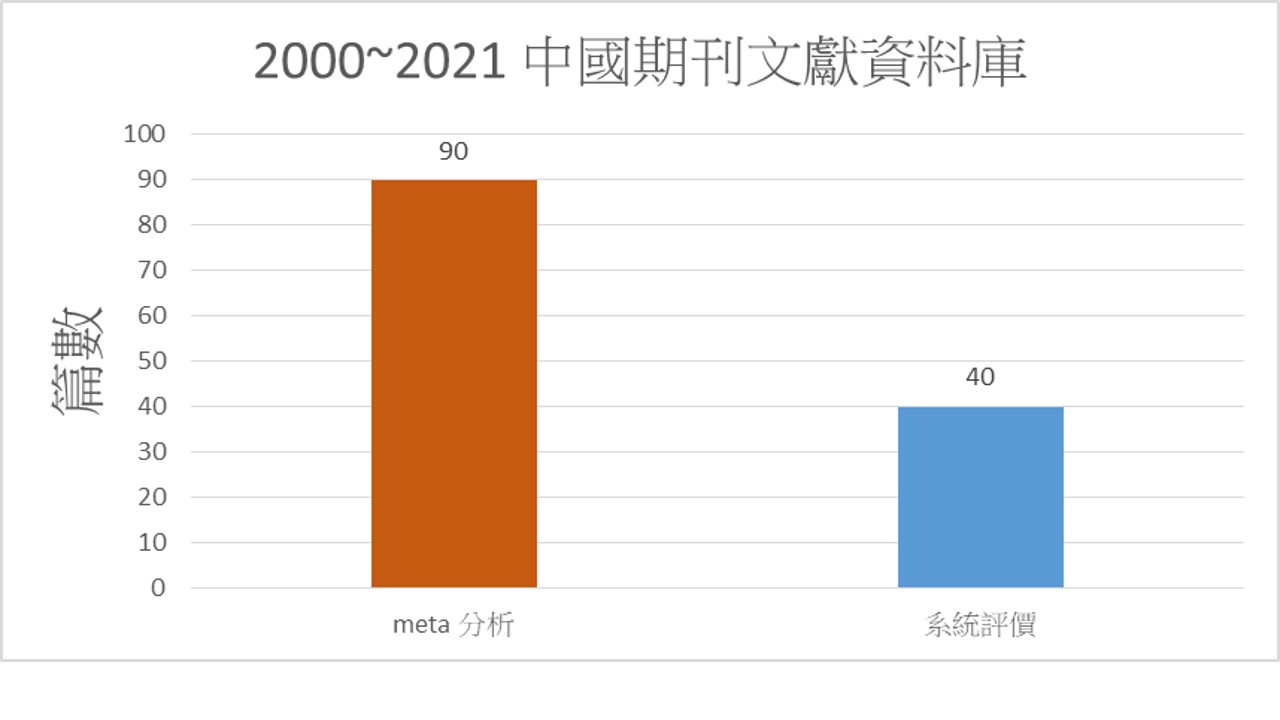
2000~2021 中國期刊全文資料庫文獻
筋膜炎
#[小針刀治療肌筋膜疼痛綜合征隨機對照研究的Meta分析](7)
龐軍、王雄將、楊立新、唐宏亮: 小針刀治療肌筋膜疼痛綜合征隨機對照研究的 Meta 分析. 時珍國醫國藥 2017; 28(9): 2282-2284.
結果: 納入文獻 11 篇,共 795 例患者。經 Meta 分析,11 項研究具有同質性,採用固定效應模型進行分析計算、合併效應量。針刀組與普通針刺組臨床療效差異有統計學意義 (OR=5.21, p<0.05),針刀組優於普通針刺組,並且在改善疼痛 症狀方面,針刀療法有較大的優勢。
頸椎病
# 針刀與針灸治療頸型頸椎病療效比較的 Meta 分析(8)
方婷、劉福水、謝洪武、周凡媛、趙梅梅、陳梅: 針刀與針灸治療頸型頸椎病療效比較的 Meta 分析. 遼寧中醫雜誌 2017; 44(11): 2244-2247.
結果: 5 個臨床隨機對照試驗被納入,共 444 例頸型頸椎病患者。Meta 分 析顯示: 針刀組治療頸型頸椎病的治癒率(OR=2.28)和遠期總有效率(OR=1.27)均高於針灸組。結論: 頸型頸椎病的臨床療效, 針刀療法優於針灸療法。
# 針刀治療椎動脈型頸椎病的 Meta 分析(9)
王佔有、周學龍、鄭景輝、謝利雙: 針刀治療椎動脈型頸椎病的 Meta 分析.
醫學綜述 2016 ; 22( 2): 353-358.
結果 有 6 篇較高品質的隨機對照文獻納入 Meta 分析,總納入病例數為 409 例。Meta 分析結果顯示,應用針刀干預 CSA 的總治癒率與針刺或西藥( 氟桂利嗪) 的療效比較差異有統計學意義( OR= 1. 78)
結論 針刀治療 CSA 的治癒率與針灸或西藥( 氟桂 利嗪) 的治癒率相比有明顯的優越性
# 針刀治療神經根型頸椎病的系統評價(10)
趙梅梅、劉福水、洪滔、周凡媛、謝洪武: 針刀治療神經根型頸椎病的系統評價. 中醫藥通報 2016; 15(4): 40-45.
結果: 納入 7 項臨床隨機對照試驗,共 941 例神經根型頸椎病患者,Meta 分析結果顯示針刀組治療神經根型頸椎病臨床總有效率、治癒率高於其 它治療方式。針刀組報導了 2 例中等程度的不良反應,均為非直視下針刀進至神經根管內口進行鏟切 剝離操作時,突然出現劇烈的竄麻感。
結論: 臨床治療神經根型頸椎病可優先選擇針刀療法,同時應進 一步改善針刀的可視性操作,提高其安全性。
# 針刀與針灸治療頸椎病療效比較的 Meta 分析(11)
魏毅: 針刀與針灸治療頸椎病療效比較的 Meta 分析. 中國處方藥 15; 3: 110-111.
結果: 文獻庫中共收入 9 個隨機對照試驗,研究物件為 2 460 例患者,經 Meta 分析結果顯 示,針刀治療頸椎病的療效較好,且不良反應較少,患者預後較好。結論: 採用針刀治療頸椎病優於針灸治療。但在實際的治療過程中應針對患者 實際情況和意願選擇治療手段。
#針刀治療頸源性頭痛療效和安全性的系統評價和Meta分析(12)
劉福水、 遊建宇、 金德忠、 方婷、 周凡媛、 趙梅梅、 陳梅: 針刀治療頸源性頭痛療效和安全性的系統評價和Meta分析. 中華中醫藥學刊 2018; 10.
結果:最終納入18個臨床隨機對照試驗,共1921例頸源性頭痛患者。Meta分析結果顯示:針刀組在治療頸源性頭痛近期有效率 (OR=4.57),遠期有效率 (OR=3. 47)、遠期治癒率 (OR=1. 75)。
結論:針刀治療頸源性頭痛療效肯定,且優於對照組。
50肩
# 針灸與針刀治療肩關節周圍炎療效比較的系統評價(14)
劉浮水、金曉飛、郭長青: 針灸與針刀治療肩關節周圍炎療效比較的系統評價
中華中醫藥雜誌(原中國醫藥學報) 2012; 27(3): 582-584.
結果:共納入6個隨機對照試驗,包括570例患者,僅有1篇高質量文獻。Meta分析結果:針刀組治療肩周炎總有效率明顯高于針灸組(OR=7.70),針刀組治療肩周炎痊愈率明顯高于針灸組 (OR=5.39)。
結論:針刀治療肩周炎療效優于針灸。
肱骨外上髁炎
# 針刀與封閉治療肱骨外上髁炎療效比較的Meta分析(15)
俞睿、 方婷、 劉福水: 針刀與封閉治療肱骨外上髁炎療效比較的Meta分析.
遼寧中醫雜志 2018; 2.
結果:10個臨床隨機對照試驗被納入,共934例肱骨外上髁炎患者。Meta分析顯示:針刀組治療肱骨外上髁炎的近期總有效率、治癒率、遠期總有效率和治療後VAS評分均高於局部封閉組。結論:肱骨外上髁炎的臨床治療,針刀療法優于局部封閉療法。
板機指
# 針刀治療屈指肌腱狹窄性腱鞘炎系統評價(16)
張繼偉、江蘇閩、吳海波、詹紅生、陳東煜: 針刀治療屈指肌腱狹窄性腱鞘炎系統評價. 中國中醫藥資訊雜誌2016; 23(7): 46-50.
結果: 納入 10 篇文獻,共計受試者 1426 例。Meta 分析結果顯示:針刀組治癒率優於封閉組[OR=13.11,針刀組總有效率優於封閉組[OR=18.26。
結論: 板機指的臨床療效,針刀組優於封閉組。
腰椎病
# 小針刀治療腰椎間盤突出症療效的 Meta 分析(17)
陳志偉、李斌傑、李國福、王紹敏、郭子坤、王薇: 小針刀治療腰椎間盤突出症療效的 Meta 分析. 中國民族民間醫藥 2018; 27(18): 46-50.
結果: 共納入 8 個 RCT,1087 例患者。Meta 分析結果顯示: 只應用小針刀治療或者小針刀聯合其他療法較不含針刀療法治療腰椎間盤突出症療效差別有統計學意義 (OR = 4. 17)。
結論: 只應用小針刀治療或者小針刀聯合其他療 法較不含針刀療法臨床總有效率高,單一使用針刀治療與針刀聯合其他療法療效差異無統計學意義,但受本研究納入原始 研究的品質和數量限制,結論尚需要更多高品質、大樣本的隨機對照試驗以進一步驗證。
# 針刀與封閉治療第三腰椎橫突綜合征療效比較的 Meta 分析(18)
陳梅、劉福水、周凡媛、趙梅梅、方婷: 針刀與封閉治療第三腰椎橫突綜合征療效比較的 Meta 分析. 中醫藥通報 2017; 16( 6): 48-52.
結果: 共納入 7 個隨機對照試驗,包括 663 例患者。Meta 分析結果 顯示針刀組治療第三腰椎橫突綜合征的總有效率 (OR=3)及治癒率 (OR=2_均高於封閉組,
結論: 針刀治療第三腰椎橫 突綜合征療效優於封閉。
# 針刀治療臀上皮神經卡壓綜合征臨床療效的Meta分析(19)
何甯甯、李開平: 針刀治療臀上皮神經卡壓綜合征臨床療效的Meta分析. 遼寧中醫雜誌 2017; 44(5): 914-916.
結果: 共納入 10 篇 RCTs,Meta 分析結果顯示: 與對照組相比,針刀治療臀上皮神經卡 壓綜合征可提高臨床療效(OR=7.53)。
結論: 與對照組治療臀上皮神經卡壓綜合征 的方法相比,針刀療法在提高臨床療效方面具有統計學差異。
膝關節
# 針刀與針灸治療膝骨關節炎療效比較的Meta分析(20)
劉福水、金德忠、吳翔: 針刀與針灸治療膝骨關節炎療效比較的Meta分析. 中國組織工程研究 2012; 16(44): 46-50.
結果: 共納入 8 個隨機對照試驗,涉及 654 例患者。Meta 分析結果顯示針刀治療膝骨關節炎的近期總有效率 和治癒率均優於針灸,其合併的OR 值分別為4.27和3.01。
結論: 針刀治療膝骨關節炎近期療效優於針灸。但納入試驗方法學品質不高,且均未報導不良事件,建議開 展高品質的隨機對照試驗加以驗證。
小針刀實證醫學(PubMed)
筋膜炎
# Effect of miniscaplel-needle on relieving the pain of myofascial pain syndrome:
a systematic review]
Liu Tong, Peng Yuanyuan, Zhu Shipeng, et al.: Effect of miniscaplel-needle on relieving the pain of myofascial pain syndrome: a systematic review. Journal of Traditional Chinese Medicine 2015; 35(6): 613-619.
結果: 納入文獻8篇,共 563 例患者。經 Meta 分析,針刀組與控制組臨床療效差異有統計學意義 (OR約1.06-2.05,p<0.05),針刀組優於控制組。
椎間盤突出
# Acupotomy Treatment for Lumbar Disc Herniation
Journal of Acupuncture Research 2020; 37(3): 177-180
結果:共80 例患者。經統計分析,針刀組與針灸組臨床療效差異有統計學意義 (Z=-4.923,p<0.05),針刀組優於控制組。
Background
The aim of this study was to examine whether the effects of acupotomy therapy were beneficial for the treatment of protrusion of lumbar intervertebral disc.
Methods
The number of patients (n = 80) were equally assigned into treatment group and control group. Treatment group was given acupotomy therapy twice a week, and control group was given acupuncture 3 times a week, for 4 weeks. The beneficial effect and changes in score of the Japan Orthopedic Association (JOA) for low back pain were observed.
Results
Among 40 cases in the treatment group, there were 25 (62.5%) with an excellent effect, 13 (32.5%) with good effect, 1 (2.5%) with a medium effect and 1 (2.5%) with poor effect, with the total experiencing an excellent/good effect of 95.0%. Among 40 cases in the control group, there were 11 (27.5%) with an excellent effect, 17 (42.5%) with good effect, 10 (25.0%) with a medium effect, and 2 (5.0%) with poor effect, with an excellent/good rate of 70.0%. The result of the rank sum test showed Z = −4.923, p < 0.05 in the comparison, indicating a significantly better outcome following acupotomy compared with acupuncture. JOA scores increased in both groups after treatment (p < 0.05), which was more significant in the acupotomy treatment group (p < 0.05).
Conclusion
Acupotomy therapy has a beneficial effect on protrusion of lumbar intervertebral disc.
# Acupotomy therapy for joint pain relief of lumbar disc herniation-systematic review and meta-analysis
Osteoarthritis and Caratilage VOLUME 26, SUPPLEMENT 1, S425-S426, APRIL 01, 2018
結果: 納入摘要513篇,文獻9篇,共1118 例患者。文獻顯示症狀改善,針刀組明顯優於針灸組(控制組)。
Purpose: Lumbar disc herniation (LDH) is a major public health problem and a serious affect on work and life. Few effective medical treatments for the disease currently exist. Acupotomy therapy as an acceptful minimally-invasive surgical treatment has been used for LDH pain. It combines tradition Chinese medicine and micro-surgery that separates neurolemma and muscle of patients’ back, resulting in pain relief. A comprehensive literature review is a key link to understand its benefits and for guiding treatment for LDH pain relief. We conducted a systematic review and meta-analysis to evaluate the efficacy of acupotomy for pain associated with LDH.
Methods: We performed a search on Cochrane Library, PubMed, EMBASE, 3 universal Chinese databases (CNKI, Wan Fang and VIP), and reference lists of published articles through Oct 2017. We include randomized controlled trials using acupotomy therapy for LDH patients who met the LDH of State Administration of Traditional Chinese Medicine (TCM diasease diagnosis and efficacy standards). The effect of acupotomy on pain relief was measured with Visual Analogue Scale (VAS) and Japanese Orthopaedic Association (JOA). Study quality was evaluated with Jadad criteria assessing randomization, single blinding, and dropout rates for each study. The differences between treatment groups were reported as mean change (P-value).
Results: After screening 513 abstracts, 9 studies met eligibility criteria and were conducted between 2008 and 2017. A total of 1,118 LDH patients (39% female, mean age = 48years, mean symptom duration = 48 months) were included. Table 1 summarizes the trials evaluating the effect of acupotomy therapy on pain relief of LDH. The typical treatment was once a week, for 1–4 weeks. Nine studies used all acupuncture .The overall quality of trials was modest (mean Jadad score = 2.5). All studies reported an effect of acupotomy on pain relief compared to controls. Figure 1 shows a meta-analysis comparing effects of acupotomy therapy with controls on pain relief. A meta-analysis comparing acupotomy with other controls is not reported due to variation in outcomes assessed. Adverse events were not reported.
Conclusions: Acupotomy treatment may improve pain which is connected with LDH. Further rigorously designed and well-controlled RCTs with long-term follow-up are warranted.
# The evaluation of clinical articles about cervical spondylotic radiculopathy treated with acupotomy](13)
LIU Xiangqian, DENG Jinfeng, LIN Dingkun: The evaluation of clinical articles about cervical spondylotic radiculopathy treated with acupotomy. Traumatology & Orthopedics 2007; 04.
結果: 文獻庫中共收入3 個對照試驗,研究物件為 352例患者,經 Meta 分析結果顯示,針刀治相對於針刺治療頸椎病的療效較好 (OR=7.84)。
結論: 採用針刀治療頸椎病優於針刺治療
膝關節炎
# Acupotomy Therapy for Knee Osteoarthritis Pain: Systematic Review and Meta-Analysis
ECAM Volume 2020 |Article ID 2168283
結果:共3021 例患者。文獻顯示症狀改善,經Meta分析,針刀組療效明顯優於控制組。(VAS score OR= -1.11 p<0.00001; WOMAC OR=-2.32 score <0.00001)
Background and Purpose. Knee osteoarthritis (OA) is a major public health problem, and currently, few effective medical treatments exist. Chinese acupotomy therapy has been widely used for the treatment of knee OA in China. We conducted this systematic review and meta-analysis to evaluate the efficacy of Chinese acupotomy in treating knee OA to inform clinical practice.
Methods. We performed a comprehensive search on PubMed, the Cochrane Library, EMBASE, and four Chinese databases for articles published prior to June 2020. We included only randomized controlled trials (RCTs) that used acupotomy therapy as the major intervention in adults with knee OA, were published in either Chinese and English, included more than 20 subjects in each group, and included pain and function in the outcome measures. Knee OA was defined by the American College of Rheumatology or Chinese Orthopedic Association criteria in all studies. We extracted the visual analogue scale (VAS) pain score, the Western Ontario and McMaster Universities Osteoarthritis Index (WOMAC) pain score, the total effectiveness rate, the modified Japanese Orthopedic Association (JOA) activities of daily living score, and Lysholm’s score. We calculated the mean difference (MD) or risk ratio (RR) for all relevant outcomes. Meta-analyses were conducted using random-effects models when appropriate. Results. We identified 1317 potentially relevant studies, thirty-two of which met the eligibility criteria and were conducted in China between 2007 and 2020. A total of 3021 knee OA patients (62.96% female, median age: 57 years, and median disease duration: 33 months) were included. The treatment duration ranged from 1 week to 5 weeks (median: 3 weeks). The typical acupotomy treatment involved releasing soft tissue adhesions and was performed once a week for 1–5 weeks until the pain was relieved. The control group treatments included acupuncture (8 studies), electroacupuncture (10 studies), sodium hyaluronate (8 studies), radiofrequency electrotherapy (1 study), and nonsteroidal anti-inflammatory drugs (NSAIDs, 5 studies).
The results from the meta-analysis showed that acupotomy led to superior improvements in the VAS pain score (MD = −1.11; 95% confidence interval (CI), −1.51 to −0.71; < 0.00001) and WOMAC pain score (MD = −2.32; 95% CI, −2.94 to −1.69; < 0.00001), a higher total effectiveness rate (RR = 1.15; 95% CI, 1.09–1.21; < 0.00001), and superior improvements in the JOA score (MD = 6.39; 95% CI, 4.11–9.76; < 0.00001) and Lysholm’s score (MD = 12.75; 95% CI, 2.61–22.89; = 0.01) for overall pain and function. No serious adverse events were reported.
Conclusion. Chinese acupotomy therapy may relieve pain and improve function in patients with knee OA. Furthermore, rigorously designed and well-controlled RCTs are warranted.
板機指
# Modified Acupotomy versus Percutaneous Release for Trigger Thumb: A Retrospective Study
J Pain Res. 2022;15:1141-1148
結果:文獻納入304位患者,共334板機指 (針刀194 vs經皮穿次140經皮穿刺術)。經統計分析,不論成功率、疼痛嚴重度、副作用和再發率,針刀組都優於經皮穿次術。
Background: Acupotomy is now increasingly used for trigger thumb, while recent evidence showed it increased the risk of nerve injury. Based on the close proximity of the neurovascular bundles and the A1 pulley, we designed a modified acupotomy. Given that percutaneous release is the common surgical treatment, this retrospective study aimed to compare the effect and safety of modified acupotomy versus percutaneous release for trigger thumb.
Methods: This is a retrospective study. All patients with trigger thumb were retrieved in the electronic records of the Department of Pain Medicine at the Beijing Hospital of Traditional Chinese Medicine from January 2016 to September 2018. Both short-term (3 months) and long-term (2 years) outcomes were evaluated using the criteria established through Gilberts et al.’s questionnaire, including triggering, residual pain, stiffness, digital nerve injury, scar, infection and satisfaction. Chi-square test or Fisher’s exact test was used to compare differences between two groups.
Results: A total of 305 patients with 334 trigger thumbs treated with either modified acupotomy (n = 194 thumbs) or percutaneous release (n = 140 thumbs) were included. Of them, 221 (72.5%) were female, and the mean age was 56.2 ± 10.0 years. The mean duration of trigger thumb lasted for 7.5 ± 3.6 months. At 3 months, all triggering were alleviated by both therapies. Although more digital nerve injury occurred in the percutaneous release (0 [0%] thumbs vs 5 [3.6%] thumbs, P = 0.012), more residual pain (30 [15.5%] thumbs vs 6 [4.3%] thumbs; rate ratio, 3.61; 95% confidence interval [CI]: 1.54– 8.43; P = 0.001) and less satisfaction occurred in the modified acupotomy group. At 2 years, more recurrent triggering, residual pain and digital nerve injury occurred in the percutaneous release group (2 [1.0%] thumbs vs 12 [8.6%] thumbs; rate ratio, 0.12; 95% CI: 0.03– 0.53; P = 0.001; 9 [4.6%] thumbs vs 22 [15.7%] thumbs; rate ratio, 0.30; 95% CI: 0.14– 0.62 P < 0.001; 0 [0%] thumbs vs 4 [2.9%] thumbs, P = 0.030, respectively). Moreover, satisfaction was significantly better in the modified acupotomy group.
Conclusion: The modified acupotomy had better long-term outcomes and satisfaction than the percutaneous release for trigger thumb, although percutaneous release has less residual pain and better satisfaction in the short term. The modified acupotomy is a treatment option for trigger thumb.
非專一性頸痛
# Acupotomy Therapy for Chronic Nonspecific Neck Pain: A Systematic Review and Meta-Analysis
ECAM Volume 2017 |Article ID 6197308
結果:文獻納入文獻10篇,433位患者,不論短期或長期止痛效果 (VAS score)或副作用,針刀組都優於控制組。
Objective. This review is to assess the efficacy and safety of acupotomy therapy in chronic nonspecific neck pain. Methods. We searched six computerised databases. Randomized controlled trials incorporating acupotomy therapy alone or combined with other conventional treatments for chronic nonspecific neck pain were included. Two reviewers screened each literature and extracted data independently according to Cochrane Reviews’ Handbook (5.1). The Cochrane Collaboration’s RevMan 5.3 software was applied for meta-analysis.
Results. A total of ten trials involving 433 patients were enrolled. The pooled analysis indicated that acupotomy therapy showed a significant improving short-term and long-term effect on effective rate and cure rate. Meta-analysis demonstrated that acupotomy therapy group was superior to control group in restoring cervical lordosis and debasing VAS score. The result of continuous data did not support statistical significance of acupotomy therapy in adjusting clinical symptom score. For adverse events, acupotomy group did not reveal obvious superiority compared to control group. Conclusions. Acupotomy therapy may be beneficial to chronic nonspecific neck pain patients. To strengthen supportive evidence, future, more rigorously designed clinical trials, adequate adverse events, and follow-up project are recommended.
五十肩
# Acupotomy Therapy for Shoulder Adhesive Capsulitis: A Systematic Review and Meta-Analysis of Randomized Controlled Trials
Evid Based Complement Alternat Med. 2019; 2019: 2010816.
結果:文獻納入文獻8篇,501位患者,經Meta 分析,針刀組VAS score優於控制組 (OR=-0.97, P=0.0003)。
Objective
Acupotomy therapy is widely used for pain management. However, the efficacy of acupotomy on shoulder adhesive capsulitis (SAC) is still uncertain. The aim of this study was to determine the effectiveness and safety of acupotomy therapy for SAC.
Methods
We searched seven electronic databases to collect randomized controlled trials (RCTs) of acupotomy for SAC published before April 2019. A meta-analysis was performed according to the Cochrane systematic review method by using RevMan 5.3 software.
Results
A total of eight RCTs involving 501 patients were enrolled. Meta-analysis showed that acupotomy was significantly better than the control group in debasing the Visual Analogue Scale (VAS) score (MD = −0.97, 95% CI = [−1.49, −0.45], P=0.0003) and improving the Constant–Murley Score (CMS) (MD = 8.46, 95% CI = [1.04, 15.87], P=0.03), and there was no significant difference in adverse events (OR = 1.24, 95% CI = [0.34, 4.52], P=0.74) between the two groups.
Conclusion
Acupotomy therapy is an effective and safe treatment for SAC, and this treatment can be recommended for the management of SAC. Due to the low quality and small sample size of the included studies, more rigorously designed RCTs with high quality and large-scale are recommended in future.
結語:
小針刀療法是朱漢章教授得自中醫傳統針刺器具與現代手術療法結合的一種醫療技術。該療法具有見效快、損傷小、操作簡單、痛苦小、花錢少等點,在中國大陸是臨床常用治療疼痛的方法。有關文獻研究方面,鑒於納入研究的高品質文獻偏少,樣本量有限,需要更進一步的設計合理、隨機方法正確、大樣本、多中心、高品質的隨機對照研究支持針刀療法的療法。
參考資料
1. 朱漢章: 針刀醫學原理,人民衛生出版社,2002,北京。
2. 郭長青: 針刀醫學,中國中醫藥出版社,2017,北京。
3. 吳緒平: 針刀醫學,中國中醫藥出版社,2016,北京。
4. 韋丹、趙焰: 神奇小針刀療法,品冠文化出版社,2006,台北。
5. 黃樞: 中國針法微形外科學,科學出版社,1998,北京
6. Liu Tong, Peng Yuanyuan, Zhu Shipeng, et al.: Effect of miniscaplel-needle on relieving the pain of myofascial pain syndrome: a systematic review. Journal of Traditional Chinese Medicine 2015; 35(6): 613-619.
7. 龐軍、王雄將、楊立新、唐宏亮: 小針刀治療肌筋膜疼痛綜合征隨機對照研究的 Meta 分析. 時珍國醫國藥 2017; 28(9): 2282-2284.
8. 方婷、劉福水、謝洪武、周凡媛、趙梅梅、陳梅: 針刀與針灸治療頸型頸椎病療效比較的 Meta 分析. 遼寧中醫雜誌 2017; 44(11): 2244-2247.
9. 王佔有、周學龍、鄭景輝、謝利雙: 針刀治療椎動脈型頸椎病的 Meta 分析.
醫學綜述 2016 ; 22( 2): 353-358.
10. 趙梅梅、劉福水、洪滔、周凡媛、謝洪武: 針刀治療神經根型頸椎病的系統評價. 中醫藥通報 2016; 15(4): 40-45.
11. 魏毅: 針刀與針灸治療頸椎病療效比較的 Meta 分析. 中國處方藥 15; 3: 110-111.
12. 劉福水、 遊建宇、 金德忠、 方婷、 周凡媛、 趙梅梅、 陳梅: 針刀治療頸源性頭痛療效和安全性的系統評價和Meta分析. 中華中醫藥學刊 2018; 10.
13. LIU Xiangqian, DENG Jinfeng, LIN Dingkun: The evaluation of clinical articles about cervical spondylotic radiculopathy treated with acupotomy. Traumatology & Orthopedics 2007; 04.
14. 劉浮水、金曉飛、郭長青: 針灸與針刀治療肩關節周圍炎療效比較的系統評價
中華中醫藥雜誌(原中國醫藥學報) 2012; 27(3): 582-584.
肱骨外上髁炎統合分析或系統系評價
15. 俞睿、 方婷、 劉福水: 針刀與封閉治療肱骨外上髁炎療效比較的Meta分析.
遼寧中醫雜志 2018; 2.
16. 張繼偉、江蘇閩、吳海波、詹紅生、陳東煜: 針刀治療屈指肌腱狹窄性腱鞘炎系統評價. 中國中醫藥資訊雜誌2016; 23(7): 46-50.
17. 陳志偉、李斌傑、李國福、王紹敏、郭子坤、王薇: 小針刀治療腰椎間盤突出症療效的 Meta 分析. 中國民族民間醫藥 2018; 27(18): 46-50.
18. 陳梅、劉福水、周凡媛、趙梅梅、方婷: 針刀與封閉治療第三腰椎橫突綜合征療效比較的 Meta 分析. 中醫藥通報 2017; 16( 6): 48-52.
19. 何甯甯、李開平: 針刀治療臀上皮神經卡壓綜合征臨床療效的Meta分析. 遼寧中醫雜誌 2017; 44(5): 914-916.
20. 劉福水、金德忠、吳翔: 針刀與針灸治療膝骨關節炎療效比較的Meta分析. 中國組織工程研究 2012; 16(44): 46-50.
